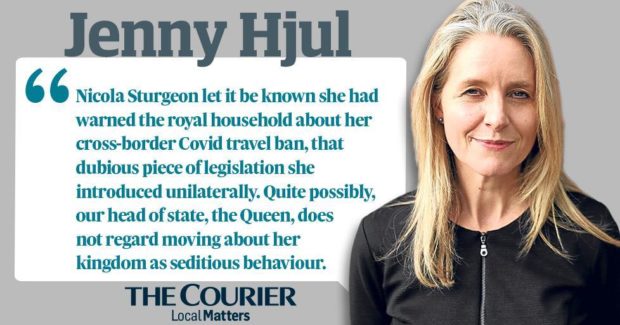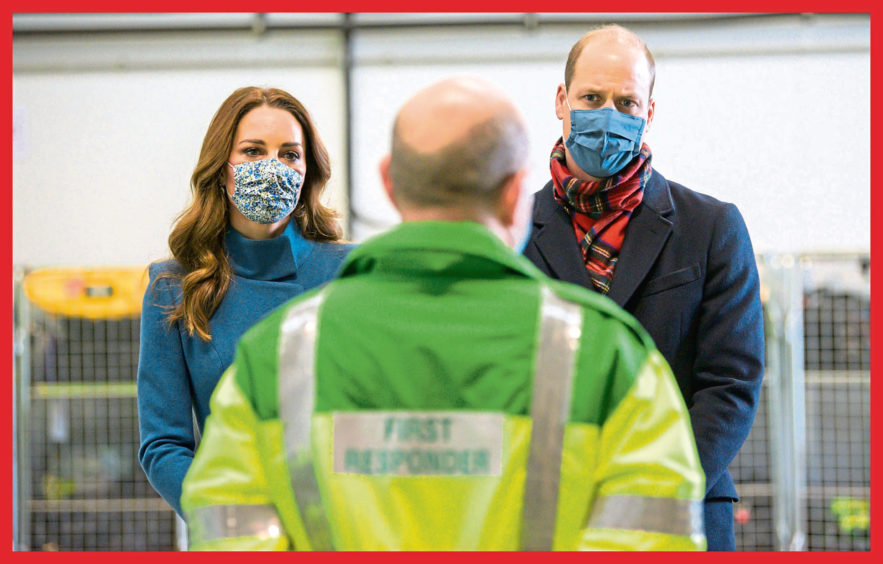The visit to Scotland this week of William and Kate barely registered when it was announced, a run-of-the-mill mini royal tour by two hard-working members of “The Firm”.
Most of the population probably reacted with polite indifference, apart perhaps from the ultra-monarchists who turned out to greet them or, at the other end of the spectrum, the hardcore republicans who want the whole family permanently furloughed.
Now, though, thanks to our nationalist government apparently not having anything better to do, the fairly innocuous pre-Christmas visit has been turned into another excuse for divisive politicking.
Nicola Sturgeon let it be known she had warned the royal household about her cross-border Covid travel ban – that dubious piece of legislation she introduced unilaterally a few weeks ago. Quite possibly, our head of state (still the Queen) does not regard moving about her kingdom as seditious behaviour, even though she herself has been confined to Windsor for some months.
More likely, royal staff interpreted the trip – which took in Scotland, England and Wales – as essential, in that the Duke and Duchess of Cambridge (known as the Earl and Countess of Strathearn in Scotland) would bring a much-needed morale boost to key workers, such as the paramedics of the Scottish Ambulance Service they met here.
Travelling for work is a legitimate exemption under Sturgeon’s rule if the work cannot be carried out from home. But there are some in the inner SNP circle who clearly think royal duties can be performed exclusively over Zoom.
In fact, one of Sturgeon’s closest advisers, US-born Edinburgh professor of public health Devi Sridhar, tweeted: “Some things I will never understand about Britain. Aren’t we all in a pandemic and living under travel restrictions?”
This lack of understanding goes to the heart of why the nationalists should never be entrusted with complete command over our lives. Covid has given them – or rather they have taken – liberties they would not normally enjoy and it has provided a useful if scary insight into how they would behave if ever left to their own devices.
Britons, whichever side of the border they live on, are broadly co-operative and law abiding, as the past few months have proved. This has enabled both Westminster and the devolved administrations to impose the extraordinary restrictions we have endured since March without any real resistance and certainly no public uprising.
Push us too far…
But push us too far, without good reason, and we may snap, in our own phlegmatic way. There are many signs this is already happening – and not just in Scotland.
When we were at last granted permission to celebrate Christmas, the train companies began the logistical nightmare of trying to shoehorn the population into the allotted five-day window from December 23-27.
But families desperate for long-awaited reunions saw the fares rocketing and the limited number of seats selling out fast, and guess what they did? With collective disobedience, they opted to travel on alternative dates.
Other quiet rebellions have seen neighbours nipping into each other’s houses for illicit dinner parties, friends from different addresses gathering for “business” lunches which, unlike social get-togethers, are allowed, and non-cohabiting couples occasionally cohabiting.
As the danger of the disease wanes in most areas of Britain, the confusing and contradictory restraints make less and less sense.
Police raids on pubs, where punters can only drink alcohol with meals (even that small pleasure is outlawed in most of Scotland), the prohibition of carol singing in and outdoors, and keeping low-transmission zones in the higher tiers.
Bizarre diktats
Most of us have learned to navigate the increasingly bizarre diktats with a measure of discernment, accepting the risks as we see fit, where there is some leeway.
Then, just when we thought the control freakery could not get worse, along comes Sturgeon with her “Covid Guide to Etiquette and Pandemic Politeness”, published at taxpayers’ expense on Monday.
Yes, while Scotland’s care home and hospital virus deaths remain alarmingly high, when the economy is in freefall, and while hospitality businesses continue to go bust, the SNP has found time to produce guidelines on “awkward” social scenarios. These include fending off a friend who rushes in for a hug, refusing invitations to parties, and shopping people for not wearing masks.
The question is not just why are they issuing this drivel but why are they doing so now? The vaccine is here, the end is in sight, Andrew Lloyd Webber is opening up his theatres (hooray!).
Some have suggested that Sturgeon’s team has been toiling over this since March. But I think the explanation is more worrying.
Inside the Bute House bubble, the power afforded by the crisis has gone to their heads.
They have micro managed our lives, treated us with contempt, and got away with it. Why stop now?






